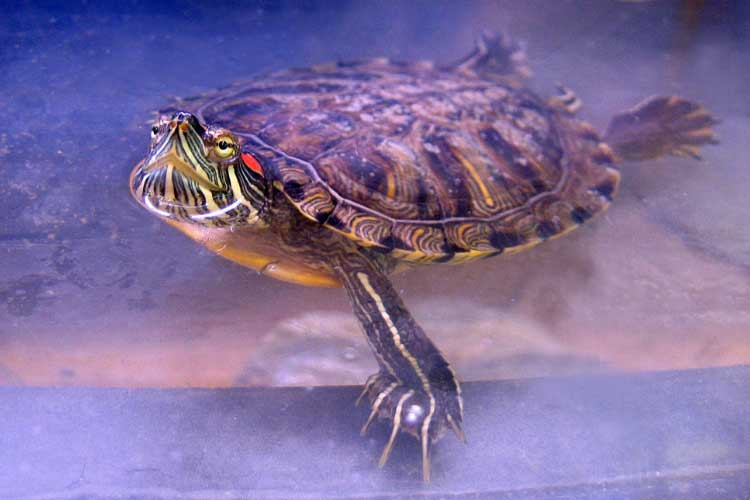Red-Eared Slider Pink Skin: Causes And Solutions (+ home remedy)
Is your red-eared eared slider skin turning pink? If yes, this guide is for you. Your turtle’s skin turning pink is something to be concerned about as it could be communicating something about your pet’s health status.
Red-eared slider pink skin is usually due to septicemia, inflammation, or lack of movement in your turtle. Growth in young turtles can also make their skin turn pinkish. Consult your vet immediately for your turtle diagnosis to find out if it has any underlying health issues.
The following guide will share full details on why your turtle’s pink skin is turning pink, all the possible causes to consider, what actions to take, and other helpful related info.
Causes of red-eared slider pink skin:
Contents
Here are the most common reasons why your red-eared slider has pink skin:
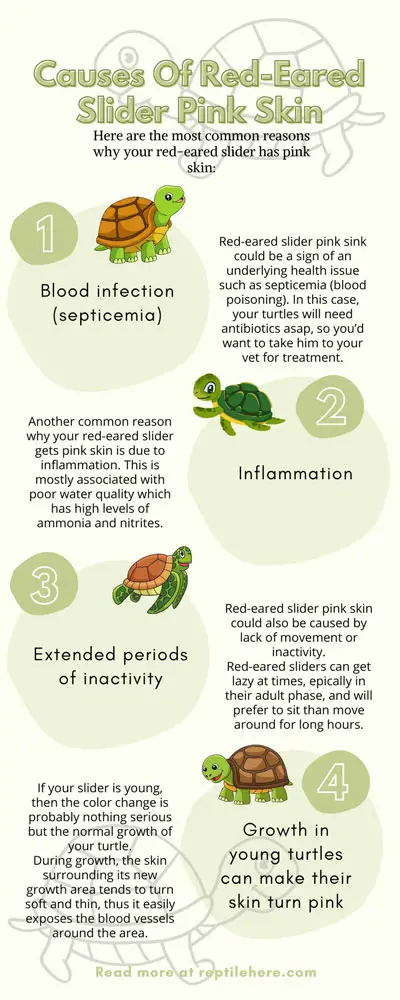
Blood infection (septicemia)
Red-eared slider pink sink could be a sign of an underlying health issue such as septicemia (blood poisoning). In this case, your turtles will need antibiotics asap, so you’d want to take him to your vet for treatment.
Potential red-eared slider septicemia causes include bacteria and parasites entering your turtle’s bloodstream through open wounds, traumatic injuries, unclean living conditions, and even localized infections.
Inflammation
Another common reason why your red-eared slider gets pink skin is due to inflammation. This is mostly associated with poor water quality which has high levels of ammonia and nitrites.
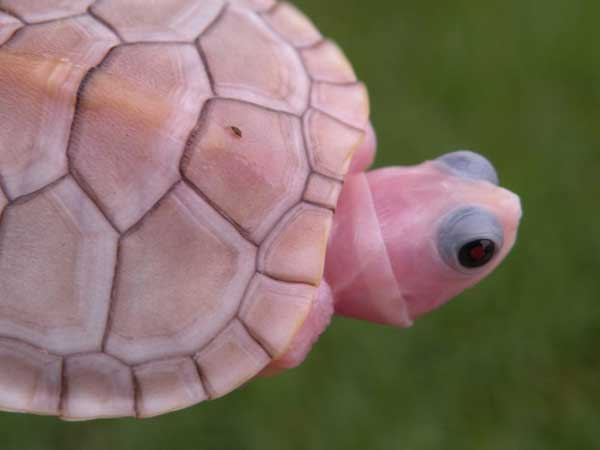
These can then lead to inflammation in your turtle which is manifested in form of shades of pink in some areas of your slider’s skin.
Extended periods of inactivity
Red-eared slider pink skin could also be caused by lack of movement or inactivity.
Red-eared sliders can get lazy at times, epically in their adult phase, and will prefer to sit than move around for long hours.
Also, if you have kept your pet in a small tank, it won’t be able to swim or move around that much. Couple long periods of inactivity and the poor circulation of these creatures, and the result is that your turtle’s skin will likely turn pink.
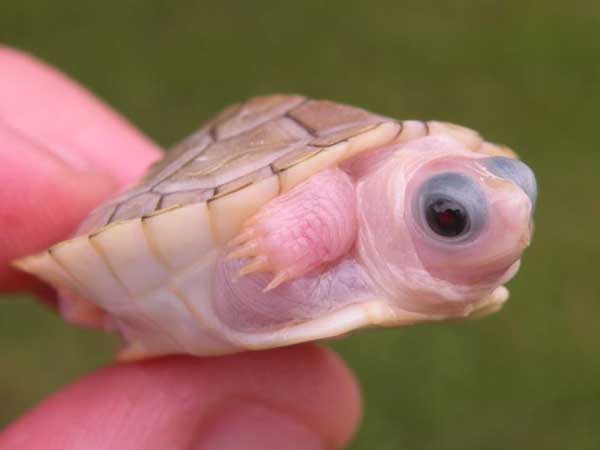
However, this is nothing to worry about as the pink appearance fades away as your turtle starts moving.
If the pink skin only happens when it basks, it could also be due to poor circulation during long hours of inactivity.
Growth in young turtles can make their skin turn pink
If your slider is young, then the color change is probably nothing serious but the normal growth of your turtle.
During growth, the skin surrounding its new growth area tends to turn soft and thin, thus it easily exposes the blood vessels around the area.
This causes the skin to appear pinkish. However, the pink appearance fades as time passes and the skin hardens.
Should you see a vet when your turtle skin turns pink?
Your turtle’s skin turning pink could be a valid sign of blood infection or inflammation and requires the vet’s attention.
Blood poisoning is caused by bacteria that travel through your turtle’s body system and overcome its organs and blood.
Over time, this can cause severe organ damage and even turn fatal! Thus, you should immediately get to your vet if you notice any sign of septicemia in your red-eared slider!
As this vet from PetCoach explains, your best bet is to take your pet turtle to a vet for him to be diagnosed and given some antibiotics that help treat the infection.
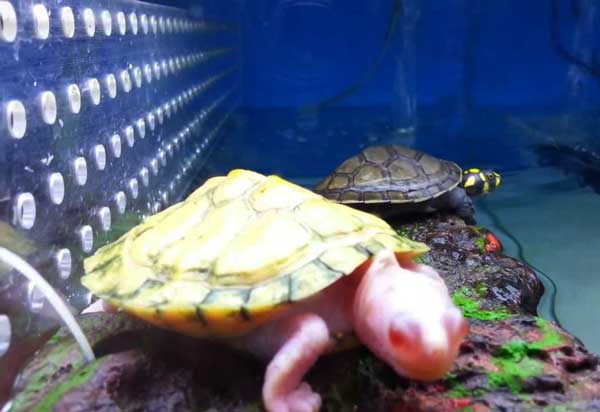
There are a few measures you can do at home to help with this condition.
First, you should also check that the water quality in your turtle tank is good.
When did you make a water change? Or have you changed anything in your pet’s habitat recently? if yes, it could also be the reason behind the pinkish turtle appearance.
You also want to ensure your turtle has a good basking platform where it completely gets off water and basks. Ensure you change the basking light every 6-9 months.
You should also monitor the diet/appetite and activity of your pet turtle as they could be behind the skin turning pink.
Why is your red-eared slider turning pink in between its claws?
Your red-eared slider turning pink in between its claws is usually nothing to worry about. If this happens during/after a basking session, it’s likely due to blood being sent to its extremities after its body heats up.
Also, if your turtle has rapidly moved around in its tank, the high level of activity may cause a pinkish appearance on its webbing.
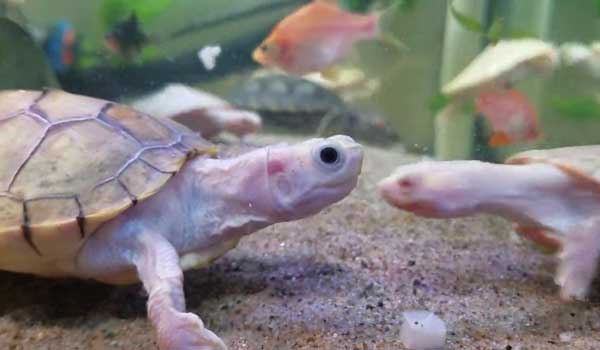
The webbing on turtles generally has little blood to help with heat conservation. but if they heat up or get too active, then the webbing becomes flush to help with thermoregulation. This is just the same way your face will turn red when exposed to high heat or after intense exercise.
If your turtle doesn’t show a behavior change, then there’s most probably nothing to worry about. You should only be worried about a potential infection if your turtle stops eating or acting normally.
Why is my red-eared underbelly turning pink?
You may also notice your red-eared slider’s underbelly turning pink. The plastron turning red or pink could be an indication of blood infection. In this case, you’d want to take your pet t the vet as soon as possible.
The vet will likely run blood tests to see what’s going on in your pet’s system and administer antibiotics if they find any infection in the blood.
However, your turtle could also be suffering from shell rot (an aggressive one for that matter), probably due to poor living conditions. This is the case of this turtle owner who found his RES to have a pinkish and fleshy plastron and went to a vet, only to be told it was shell rot!
You’d want to check whether your turtle has a proper basking area where he/she completely gets out of the water to dry off, access to UVB and heat lamps, and whether the basking and water temperatures are correctly set. On top of this, the water quality should be clean.
However, the plastron turning red could also be nothing to worry about as it sometimes happens to young red-eared slider turtles that are growing fast.
If there are no additional signs of illness in your turtle, e.g. loss of appetite, lethargy, etc., then there’s probably nothing wrong with your turtle.
Why does my red-eared turtle skin turn red?
Your red-eared slider having a red tint to its skin could also indicate she’s suffering from septicemia. This is serious and you should call your vet ASAP for your turtle to be diagnosed and treated before the infection becomes fatal!
It could also be due to inflammation, probably caused by poor water quality. Poor filter system and dirty water will allow concentration of ammonia and nitrates which will then irritate your turtle’s skin and result in inflammations. These can appear as pink or red.
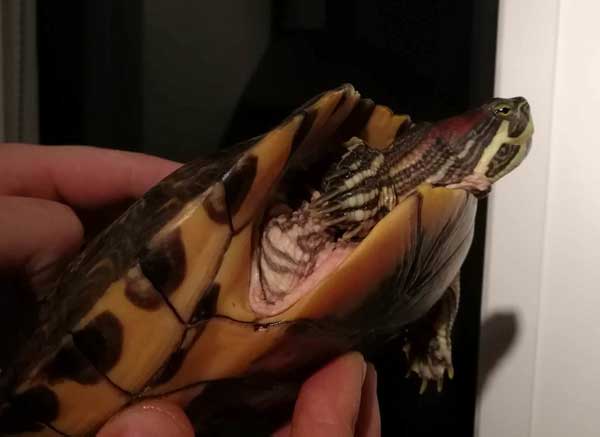
You’d also want to check if there is something you recently added to the water or whether the underwater heater is guarded to keep your turtle from getting burned and turning red.
The food you give your turtles could also be a problem. For instance, if you feed your RES red pellets, then they can cause skin discoloration due to the food dyes present in the commercial food. Or look for a different brand of pellets that doesn’t have dyes or added colors in its food.
FAQs:
Red spots on your red-eared slider skin could be caused by a blood infection, inflammation, inactivity, and high heat in the water or basking area. Young turtles’ skin may also turn red or pink as they grow. Check your turtle’s living conditions and adjust them accordingly to see if they help solve skin discoloration.
Oral antibiotics are the common way to treat septicemia in turtles. However, your vet may also recommend a topical antibiotic and fluid therapies, depending on the condition of your turtle and how advanced this illness is.
There’s no specific period over which you can expect septicemia to go away as it varied from turtle to turtle. If the disease is caught early and it responds well to aggressive treatment, then you should be able to see positive signs after about one week. Your turtle vet will definitely give you a more satisfying answer regarding the recovery period of your pet.
Final Verdict
The skin of your red-eared slider turtle pet turning pink or red isn’t something to take lightly. It could be a sign of septicemia or blood infection, which requires vet attention before it turns fatal. Sometimes, it could be due to inflammation caused by poor water quality. Lack of exercise in your turtle can also cause the pink skin problem. Young turtles’ skin also tends to turn pink as they grow with time.
We hope that you have learned all the possible causes for red-eared slider pink skin in this guide and what steps to take to solve the problem. Make sure you constantly check the living conditions of your turtle, including tank space, and water quality, and replace the basking light every 6-9 months. This will ensure your turtle has perfect living conditions and prevents the possibility of infections.


